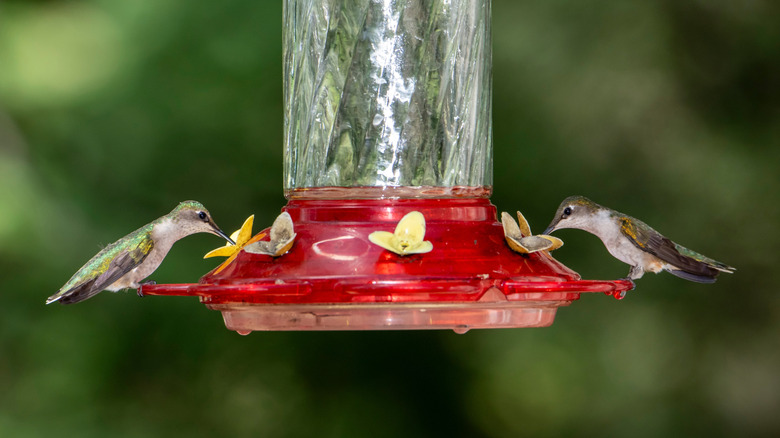Keep Hummingbirds Safe By Only Using One Type Of Sugar In Your DIY Nectar
We may receive a commission on purchases made from links.
Despite being one of the smallest birds, hummingbirds work up quite an appetite and need to consume a lot of calories, which is why they've been to known to visit as many as 2,000 flowers a day. They've also been known to munch on the occasional small insect. Still, a stop at your feeder can give them a much-needed boost, and we all want to provide a safe, healthy snack for these beloved garden visitors.
Attracting adorable little hummingbirds to your yard can brighten any gardener's day, so make sure that the nectar in your feeder is safe for the fast-moving little ones. The only safe nectar for hummingbird feeders is a mixture of white table sugar and water. Whatever you do, don't use honey in your feeder, which can grow fungus and become poisonous to them. Avoid anything with molasses, including brown sugar and raw sugar. Molasses can grow bacteria, which isn't great for the birds, and it also contains minerals that could be bad for their diet.
Don't use artificial sweeteners, either, which can contain chemicals that could hurt your little visitors. Use caution even with some store-bought nectars, too, since they can contain chemicals or corn syrup that might not be healthy for hummingbirds. Don't have a feeder? You can learn how to make a hummingbird feeder with recycled water bottles.
The quick-and-easy nectar recipe to keep hummingbirds coming back for more
For the safest and healthiest nectar for your feeder, simply mix together one part white, refined sugar –- that's just plain table sugar -– to four parts water, as this sugar combo best mimics the sugar content of natural nectar they find in flowers. Boiling the water isn't necessary, but be sure to store any sugar water that doesn't fit in the feeder in your fridge.
Don't forget to change out your nectar every one or two days to avoid growing mold that might make hummingbirds sick. Replace sugar water right away if it turns cloudy or smells bad. While hummingbirds are attracted to the color red, don't dye the nectar, as food coloring includes chemicals that might harm the birds. Instead, pick a feeder that's already decorated with red accents, like this Bolite hand-blown glass hummingbird feeder.
When it comes to placement of your sugar-water feeder, make sure it's away from other bird feeders, as larger birds tend to frighten off the smaller ones. Keep hummingbirds coming back to your yard with this unique red-blooming plant, the red bottlebrush plant (Melaleuca citrina). The gladiolus (Gladiolus spp.) and cannas (Canna generalis) and on the list of flower bulbs to plant for hummingbirds, as well. Stick to these tips and you'll keep hummingbirds coming back to your garden again and again.

